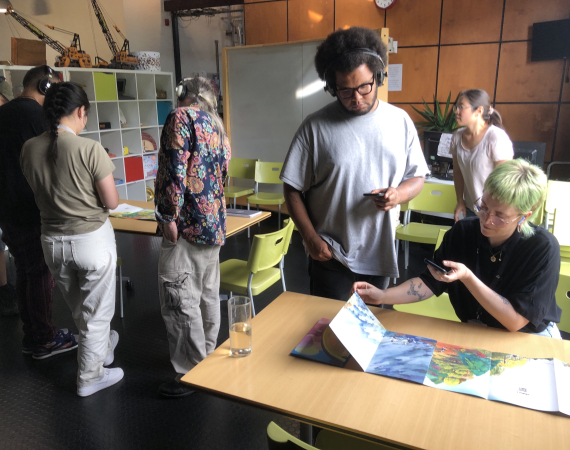Studio blog
Posted on Tue 13 Feb 2024
Seven lessons I’ve learned from evaluating our work in Pervasive Media Studio
Pervasive Media Studio Research Lead, Furaha Asani, shares some lessons the core studio team have learned across all their work and working processes.

An image of a Show & Test Event in Pervasive Media Studio; Image Credit: Martin O'Leary
Posted by

Furaha Asani
Furaha was Watershed's Research Lead, supporting ongoing research across Pervasive Media Studio. Furaha is also a mental health advocate and writer.Pervasive Media Studio, this vibrant space filled with a diverse and widely multi-talented group of residents, is run by a small(ish) multidisciplinary team of Watershed staff members. As a team we are made up of creative producers, creative technologists, action researchers, coordinators, and talent development experts. We are led by an executive producer who oversees the work of the three teams: the studio community, talent development, and research teams each with their own team lead. And while we have these three work strands, most of our work actually overlaps significantly.
As the lead of the research team and a keen storyteller myself, I’ve spent time monitoring and evaluating some of our learnings in the three years that I’ve been a part of the studio. Based on my insight, and drawing from those around me, here is a non-exhaustive list of seven things we’ve learned from our work and working processes.
Beginnings and Endings
I’ve learned that it’s crucial to spend time planning both the beginning and the ending of a project or programme, including what the terms of reference of the working group will be in addition to the off-boarding process. As a staff team we spend a significant amount of time ideating and planning projects, filing all the administrative work that accompanies project initiation, and conducting various on-boarding processes for project participants and ourselves. As a wider creative team in Watershed, we also have dedicated monthly time to share with the cinema and comms teams about what we have ‘bubbling under’ and receive their feedback. Once projects have commenced, we will typically tend to implement some of our tried-and-tested welcoming methods, then guide any new project group we’re working with in setting up terms of reference on how we want to be together as a working group (which we have a helpful ‘how to’ guide for).
Our projects overlap timewise in a way where as one is wrapping up another is already beginning; so, there is hardly any lull in our work as a whole. However, because of this way of working, it can be hard to ‘feel’ the ending of any one project. Because of this, over the past two years we’ve tried to be more conscientious about our endings. This means that along with having clear tapering off support for all participants in our projects, as a delivery team we also book in as many reflective debriefing sessions as we need as well as some form of an ‘ending’ gathering. We are now more proactive about our off-boarding processes and will usually have a concluding celebration in the form of a sharing event (or showcase on some occasions).
Freedom to Fail as a tenet of R&D
One of the most poignant assertions I’ve heard in this space came from Exec Producer Jo Lansdowne, who continuously states that “we are comfortable with funding failure”. And no, we’re not referring to failure in the same sense of- as described by Siobhan Leddy- the “macho-corporate mantra of Silicon Valley’s denizens”; rather, what Jo means is that the studio is a space in which people will be supported to produce the best version of the work they can produce, but if that production also happens to be a fail then that is ok too. In other words, the freedom to fail comes with support because we understand that ‘failure’ comes with different risks relative to circumstances, realities, and stability of people’s lives and livelihoods.
The concept of failure is part and parcel of the R&D process. It certainly is not the first time I’ve heard a researcher talking about the need to tell the story of failure, either. It is however the first time I’d heard and seen that failure as an outcome in R&D is actually acceptable, and that the studio would like to be a place where people should feel safe to fail. Of course, we want as much success as possible- and we have seen our community succeed phenomenally; we would hope that part of that success is down to R&D they’ve been supported in doing through, with, or in spite of failure.
Capacity, Resource, and Power as fundamentals of change
While the studio strives to provide support for a community which produces great work, as a small team we are limited in how much we can actually do. Inclusion Producer Tony Bhajam has spent many years speaking about three factors- capacity, resource, and power- and about how the differing levels of each that any person or organisation has will affect the quality of change that that person or organisation can make. Together with Design Strategist Gill Wildman and Jazlyn Pinckney (Executive Producer at Air Giants), Tony co-produced an inclusion framework for change that comes as an interactive activity with prompts and provocations that get users thinking about their ‘touchpoints’- which is any place or space in which there exists the potential to meet and interact with people outside of the organisation. The framework functions as a change-making engine, guiding and challenging people and organisations towards improving their inclusion practice based on the capacity, resource, and power they possess.
Like many of the other projects developed in the studio, this change-making engine went through several iterations, with Tony prototyping and testing the engine in various projects of ours, before co-producing the current form. Importantly, the co-production team acknowledge that this framework is not meant to be static, but users should keep evolving and adapting it.
Responsiveness
Responsiveness means that the map of all our projects probably forms a web-like structure as opposed to a linear one. A large volume of the work we do in the studio is emergent, which in this context simply means that our ideas are born not only out of subjects of interest within our network but also out of prior projects we have been a part of. This emergence is only possible because we’re on the lookout for best practice and how to improve upon it and take it forward. For example, one of our foundational collaborative research projects as a studio was REACT which used the Studio’s sandbox methodology (which we continue to evolve). REACT also set in motion the wheels for the South West Creative Technology Network (SWCTN) and Bristol+Bath Creative R&D, not just in the work itself but in the creative ecology these projects established in the West of England and South West region.
We have always had a talent development stream dedicated to supporting young people and those early in their career. Our talent development team then produced Rife Magazine, which was a platform for the opinions of Bristol’s young people. Rife Magazine became one of the hubs where young creative professionals from Creative Workforce for the Future (CWFTF) were embedded. Part of our responsibility within responsiveness also entails knowing when it’s time to draw certain projects to a close- as was the case with Rife in 2022. And now our talent development team runs Makeshift- a space for early career creatives to focus on filmmaking, art, and creative technology.
Being responsive further means being agile in our monitoring, evaluation, and learning processes which allows us the flexibility to iterate. And it’s this flexibility that means that we’re usually reflecting on one of our programmes or processes and thinking about how to make it better. For example, after spending hundreds of hours over many years reading hundreds of applications for Watershed’s Winter Residency programme, and considering the amount of unpaid labour that went into writing them, Vic Tillotson (Talent Development Lead) and Martin O’Leary (Studio Community Lead) decided a change was needed. With support from Jerwood Arts, they developed and implemented a system of random selection which has had a significantly positive impact on how we run selection processes not just in our winter residency programme but across some of our other programmes too.
Outputs can take many forms
Because some of our work falls under the umbrella of larger collaborative projects, we will usually have some obligations to fulfil in terms of the outputs we produce. We try to be flexible about what format these outputs take and often find ourselves steering towards producing something engaging and shareable, and that we will likely be able to use in future work. For example, Zoe Rasbash’s action research has focused on how creative SMEs can make tangible change towards climate action and resulted in the publication of the creative action climate toolkit. Zoe’s work has also fed into the continued work of Watershed’s environmental action team and has enabled us to co-produce Grounding Technologies with our UWE partners.
So many of the wonderful people we’ve worked with over the years also count the sharing and story-telling of their practice and processes and work/what they’ve made, through lunchtime talks and any other sharing events we run, towards their outputs. We have such a rich archive of multimedia resources-from podcasts to blogs, vlogs, real-time experiences, and many other forms- that tell stories of research and community practice within our community and wider network. Have a look through this archive here:
https://www.watershed.co.uk/studio/projects
Accountability and Repair
Clarity of and constant improvement in our mechanisms for raising important issues has been a key feature of our accountability and repair work. We have not always gotten things right in our work and processes. Sometimes this has been due to our own errors and faults, and sometimes it has been due to things going wrong within a programme we’re overseeing, on our premises, or on our watch. It is critical to implement a reparative process that must include an apology, support and redress for the person aggrieved, investigation of the grievance, learning for the team, and any other appropriate action. It is also extremely important to communicate to all parties on what exactly will be done to ensure that any wrongdoing will not happen again, or at least that necessary safeguards and/or checkpoints will be put in place to mitigate future occurrences. Part of this learning has led us to constantly review and clarify mechanisms people- within and outside our network- can use for raising issues. We are dedicated to continued learning and are open to receiving feedback on how to improve.
Trust
Trust isn’t something that can or should be quantified, and in my opinion, neither is it a virtue I’d be comfortable self-conferring. Bearing this in mind, two-way trust is a fundamental factor to ensure that great work can get done and a long-term relationship can be nurtured thereafter. This latter phenomenon, of long-lasting relationships, is one that has underpinned the story of the studio and our community both locally and internationally. And while we hope to continue doing brilliant work with many of our friends far and wide, it’s also part of our remit and responsibility to keep opening up our work and opportunities to new audiences, makers, and potential partners.
But back to ‘trust’; what we’ve found is that when people express gratitude for us trusting them to make good use of an opportunity we’ve facilitated, that trust seems to have materially supported them somehow. We tangibly demonstrate this trust in a number of ways including not having contracts that are highly risk averse, trying- wherever we can- to pay people more money up front than might be typical, and not asking for lots of reporting- which can sometimes be in tension with our funders’ requirements. We also don’t do silly things with IP.